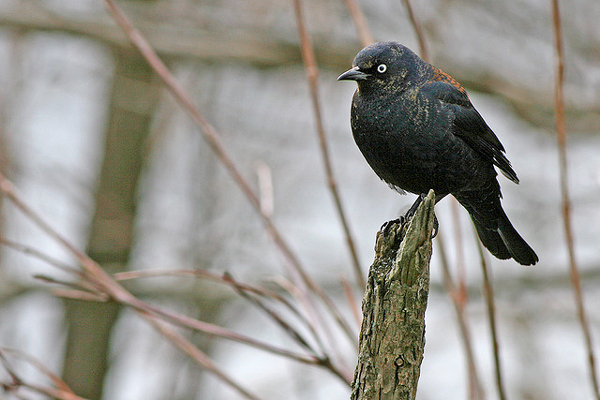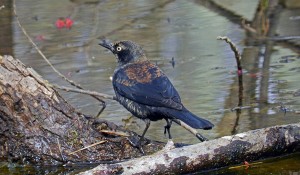
The Rusty Blackbird, is an ubiquitous species that has caught the attention of the Audubon Society. The reason – numbers of the species are plummeting, and causes of the decline are not well understood. The rusty’s breed in Alaska’s wetlands, and Audubon, along with other groups interested in the birds’ welfare, is asking Alaskans to help.
Its call has been likened to the sound of a VHS tape rewind and it has been described unflatteringly as a “non-descript little black bird.” But the little black bird with the intensely bright yellow eyes came under the gaze of East Coast ornithologist Dr. Russ Greenberg, who wondered why the once-abundant bird was disappearing.
Greenberg, who died last year, authored several studies on the rusty blackbird, and founded the International Rusty Blackbird Working Group almost a decade ago to rally people to the cause. Beth Peluso is with Audubon Alaska.
“And I think one of the things that is really interesting to me about this is that it highlights how our Alaska birds are tied in to other places,” Peluso said.

Audubon wants to recruit volunteers to help track the migratory pattern of the rusty blackbird all through the U.S. and Canada this spring.
“There may be something happening on the wintering grounds or along the migration routes that are affecting what’s happening with our birds here. So this project is really great because it is going to give us a snapshot all the way through, from wintering grounds all the way up through the migration to where they are nesting up here in Alaska.”
Joining the 2014 Rusty Blackbird Blitz is as easy as posting to Facebook, and you don’t have to be a serious birdwatcher to do it. Peluso says citizen scientist data is collected on a website: eBird.org. The idea is to document arrivals of the rusty blackbird into Alaska.
“They are really tricky to survey,” Peluso said. “They don’t nest in colonies. They are kinda dispersed a little bit when they are nesting, so they are kind of hard to get a good count on.”
But the information gained may help to unravel a mystery: why is the Rusty Blackbird in the steepest decline of any bird in North America? Audubon says the birds’ numbers have dropped between 88 and 98 percent since the mid-1960s. And that has propelled the little bird to the top of the International Union For Conservation of Nature’s Red List – a list of threatened species.
So now here we are on the Potter Marsh boardwalk on the outskirts of Anchorage. Peluso, who’s hauling a spotting scope over her shoulder, says it’s one of the better viewing spots.
“I thought I’d try scanning the spruce trees. So you really have to be pretty quick, you have to be pretty quick on the uptake if they are flying by. you have to know.. yeah, and since they are migrating they are a little harder to find,” Peluso said. “They are not just sitting there singing, like they would if they were on their breeding territory. So it is a little tricky. ”
She says the Rustys are just starting to arrive in Alaska this week
“I’ve been checking eBird every couple of days to see the reports starting to show up all of a sudden,” Peluso said. “There were a couple down in Juneau, and a couple here and there. And now there are a whole bunch up in Anchorage. There’s a bunch up in Fairbanks. It’s really fun to see how fast it happens.”
Steve Matsuoka, a U.S. Fish & Wildlife Service biologist, joins us for the walk. He says Rusty Blackbirds breed in the boreal wetlands of Alaska and the Yukon. Climate change could be one culprit in their decline.
“There’s growing evidence based on chronologies of aerial photographs dating back to the 1950s that a lot of the lakes and ponds and water bodies in boreal Alaska at least are shrinking in size. And we think that that is due to a combination of evaporation.. things are simply warming up,” Matsuoka said.
The marshy areas provide lots of bugs the birds like to eat.
But little is known of their patterns: where they stopover and what predators threaten them. Matsuoka says habitat degradation in the South is a factor but there is still no smoking gun. Until Greenberg got interested a decade ago, no scientific study had been done on rusty blackbirds since the 1920s.
“Pretty much like anything that he looked at anywhere in North America, showed the same trend for the species,” Matsuoka said. “So which was this ninety percent decline that had occurred over at least the last 40 years and maybe dating back a century. ”
Matsuoka says reports from the mid 1800s indicate that the Rusty Blackbird once filled the sky with its migrations.
More recent studies show good survival rates in the birds’ early life cycle, leading to the theory that the harm is in wintering grounds in the Southern United States. Other species are getting squeezed between drying wetlands up North, and disappearing habitat down South. The Lesser Yellowlegs, for instance, also breeds in boreal wetlands.
APTI Reporter-Producer Ellen Lockyer started her radio career in the late 1980s, after a stint at bush Alaska weekly newspapers, the Copper Valley Views and the Cordova Times. When the Exxon Valdez ran aground in Prince William Sound, Valdez Public Radio station KCHU needed a reporter, and Ellen picked up the microphone.
Since then, she has literally traveled the length of the state, from Attu to Eagle and from Barrow to Juneau, covering Alaska stories on the ground for the AK show, Alaska News Nightly, the Alaska Morning News and for Anchorage public radio station, KSKA
elockyer (at) alaskapublic (dot) org | 907.550.8446 | About Ellen



